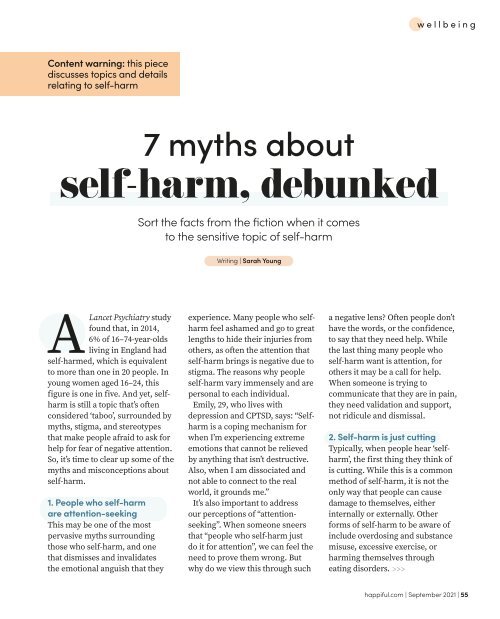Create successful ePaper yourself
Turn your PDF publications into a flip-book with our unique Google optimized e-Paper software.
wellbeing<br />
Content warning: this piece<br />
discusses topics and details<br />
relating to self-harm<br />
7 myths about<br />
self-harm, debunked<br />
Sort the facts from the fiction when it comes<br />
to the sensitive topic of self-harm<br />
Writing | Sarah Young<br />
A<br />
Lancet Psychiatry study<br />
found that, in 2014,<br />
6% of 16–74-year-olds<br />
living in England had<br />
self-harmed, which is equivalent<br />
to more than one in 20 people. In<br />
young women aged 16–24, this<br />
figure is one in five. And yet, selfharm<br />
is still a topic that’s often<br />
considered ‘taboo’, surrounded by<br />
myths, stigma, and stereotypes<br />
that make people afraid to ask for<br />
help for fear of negative attention.<br />
So, it’s time to clear up some of the<br />
myths and misconceptions about<br />
self-harm.<br />
1. People who self-harm<br />
are attention-seeking<br />
This may be one of the most<br />
pervasive myths surrounding<br />
those who self-harm, and one<br />
that dismisses and invalidates<br />
the emotional anguish that they<br />
experience. Many people who selfharm<br />
feel ashamed and go to great<br />
lengths to hide their injuries from<br />
others, as often the attention that<br />
self-harm brings is negative due to<br />
stigma. The reasons why people<br />
self-harm vary immensely and are<br />
personal to each individual.<br />
Emily, 29, who lives with<br />
depression and CPTSD, says: “Selfharm<br />
is a coping mechanism for<br />
when I’m experiencing extreme<br />
emotions that cannot be relieved<br />
by anything that isn’t destructive.<br />
Also, when I am dissociated and<br />
not able to connect to the real<br />
world, it grounds me.”<br />
It’s also important to address<br />
our perceptions of “attentionseeking”.<br />
When someone sneers<br />
that “people who self-harm just<br />
do it for attention”, we can feel the<br />
need to prove them wrong. But<br />
why do we view this through such<br />
a negative lens? Often people don’t<br />
have the words, or the confidence,<br />
to say that they need help. While<br />
the last thing many people who<br />
self-harm want is attention, for<br />
others it may be a call for help.<br />
When someone is trying to<br />
communicate that they are in pain,<br />
they need validation and support,<br />
not ridicule and dismissal.<br />
2. Self-harm is just cutting<br />
Typically, when people hear ‘selfharm’,<br />
the first thing they think of<br />
is cutting. While this is a common<br />
method of self-harm, it is not the<br />
only way that people can cause<br />
damage to themselves, either<br />
internally or externally. Other<br />
forms of self-harm to be aware of<br />
include overdosing and substance<br />
misuse, excessive exercise, or<br />
harming themselves through<br />
eating disorders. >>><br />
<strong>happiful</strong>.com | September <strong>2021</strong> | 55

















